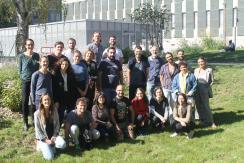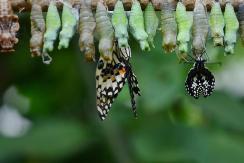COEVOL Multi-Scale Coevolution
Living systems are highly integrated, with a multitude of levels of organization, from molecular and intra-cellular scales to ecosystems. Complex organisms are themselves consortia of macro- and micro-organisms, which work together with their host to build the individual. Yet, each of these organisms can function and evolve in the short term according to its own logic, possibly in conflict with other higher or lower levels, or with other time scales. The once common idea among evolutionists that natural selection results in organisms perfectly adapted to their environment is now severely undermined. Not only because, as the Red Queen explains to Alice, one has to run relentlessly to keep its place in a changing environment, or because past evolutionary history and chance constrain the possibilities of present adaptation, but also because different levels of selection have interests that are generally difficult to reconcile.
Multi-scale coevolution resets classical questions in evolutionary biology
One example, of particular interest is the question of the source of heritable variations. The phenotype of organisms in a population is influenced not only by variations in their nuclear and mitochondrial genomes, the dynamics of which is the object of population genetics, but also more and more patently by the consortium of microbes and genetic elements that constitute its microbiome and virome. The hologenome designates this complex assembly of genetic materials, which obey different rules of transmission and different evolutionary strategies. The ability of symbionts to manipulate host phenotypes or to interfere with each other influences the evolutionary dynamics of all players in ways that are yet poorly understood. In addition, new questions arise, such as the importance of co-adaptation in these systems and their consequences in maintaining cohesive biological systems.
- Symbiosis: a response to and a source of divergent selection
Using a variety of approaches combining experimental evolution, genomic, functional, phenotypic and behavioral data, we aim to test whether symbiosis facilitates diversification and to characterize the underlying microevolutionary processes.
- Ecological networks of horizontal gene transfer
We develop original methods to detect gene transfer and we investigate the factors that influence the routes of gene transfers among microbes but also among insects.
- The interplay between symbiosis, infection and immunity and its evolutionary consequences
We try to understand the intimate interaction of hosts with pathogens, symbionts and transposable elements and how it affects the extended phenotype of the host.
- Transgenerational inheritance and environment changes
We try to decipher the molecular mechanisms that underlie rapid adaptation to environment and to test for transgenerational inheritance of fitness traits.
- Intragenomic conflicts and demography
We are developing models to test whether changes in the demography of the host affect the dynamics of transposable elements.
- The determinism of phenotypic convergence
We study the genomic basis of convergent phenotypic evolution in particular in the case of animals and plants adaptation to increasing temperature and decreasing water.
- Reconciling the tree of life
We develop phylogenetic methods for “reconciling” gene/species or host/symbiont histories and use these methods to explore the bulk of extinct or undescribed species and the history of association of symbiotic microbes with their hosts.
Integrating methods
The methods we use to tackle the questions raised by multi-scale co-evolution extend from theory, modelling and simulation to big data analysis, lab (notably on insects), and to a lesser extent, field activities.
Implication of research, responsibility of researchers and citizen sciences
From our research (some of which have immediate consequences in health, agriculture and ecology) and our concerns about the responsibility of scientists in society, we are committed to promote an “implicative” research. The implicative position means that we try to work on the link between science and society, not only through a one-way communication, applying or explaining our science, but also favoring early discussions on research projects, that may influence our research directions.
Publications
Display of 61 to 90 publications on 709 in total
Feeding, sex, and development shape the relative quantity of Wolbachia, the nutritional obligatory symbiont of bed bugs
Rencontres du Réseau Ecologie des Interactions Durables 2023 .
Poster
see the publicationFeeding, sex, and development shape the relative quantity of Wolbachia, the nutritional obligatory symbiont of bed bugs
Journée scientifique enjeu « santé globale et bio‐ingénierie » de l'INSA Lyon .
Poster
see the publicationDynamics of endosymbionts in bed bugs during development
Groupe Régional de Recherche en Microbiologie des Interactions (G-RREMI) .
Poster
see the publicationFunctional analysis of interactions between bed bugs and their nutritional symbiont Wolbachia
Rencontres du Réseau Ecologie des Interactions Durables 2023 .
Poster
see the publicationFunctional analysis of interactions between bed bugs and their nutritional symbiont Wolbachia
Journée scientifique enjeu « santé globale et bio‐ingénierie » de l'INSA Lyon .
Poster
see the publicationContribution of TE to the phenotype and plasticity in Drosophila melanogaster
CNET (24th congrès national des éléments transposables) .
Poster
see the publicationGenomic changes during the evolution of the Coxiella genus along the parasitism-mutualism continuum
Peer Community Journal . 3 : e41
Journal article
see the publicationPlant choice for oviposition in the phytophagous insect Bemisia tabaci: cytotype, including symbionts, knows best!
Animal Behaviour . 200 : 147-157
Journal article
see the publicationThe for gene as one of the drivers of foraging variations in a parasitic wasp
Molecular Ecology . 32 ( 7 ) : 1760-1776
DOI: 10.1111/mec.16834
Journal article
see the publicationStudy of host-symbionts coevolution in the whitefly Bemisia tabaci: an experimental evolution approach
13e Rencontre du Réseau Français de Biologie Adaptative des Pucerons et Organismes Associés (BAPOA) .
Conference paper
see the publicationSecondary symbionts influence feeding and oviposition behavior in the whitefly Bemisia tabaci
XII European Congress of Entomology .
Poster
see the publicationA comprehensive evolutionary scenario for the origin and neofunctionalization of the Drosophila speciation gene Odysseus (OdsH)
G3 . 14 ( 3 ) : jkad299
Journal article
see the publicationAn evolutionary timescale for Bacteria calibrated using the Great Oxidation Event
Preprint
see the publicationEvaluation of Methods to Detect Shifts in Directional Selection at the Genome Scale
Molecular Biology and Evolution . 40 ( 2 )
Journal article
see the publicationApproche globale des éthiques dans les relations sociétés/nature
: 211-219
Report
see the publicationA major 6 Mb superlocus is involved in pyrethroid resistance in the common bed bug Cimex lectularius
Evolutionary Applications . 16 ( 5 ) : 1012 - 1028
DOI: 10.1111/eva.13550
Journal article
see the publicationNutritional symbioses in triatomines: who is playing?
Peer Community In Evolutionary Biology . : 100629
Journal article
see the publicationImpact of Heat Stress on Transposable Element Expression and Derived Small RNAs in Drosophila subobscura
Genome Biology and Evolution . 15 ( 11 ) : evad189
DOI: 10.1093/gbe/evad189
Journal article
see the publicationLarval density in the invasive Drosophila suzukii : Immediate and delayed effects on life‐history traits
Ecology and Evolution . 13 ( 8 ) : e10433
DOI: 10.1002/ece3.10433
Journal article
see the publicationA quantitative, genome-wide analysis in Drosophila reveals transposable elements’ influence on gene expression is species-specific
Genome Biology and Evolution . 15 ( 9 ) : evad160
DOI: 10.1093/gbe/evad160
Journal article
see the publicationChimeraTE: a pipeline to detect chimeric transcripts derived from genes and transposable elements
Nucleic Acids Research . 51 ( 18 ) : 9764-9784
DOI: 10.1093/nar/gkad671
Journal article
see the publicationEndoparasitoid lifestyle promotes endogenization and domestication of dsDNA viruses
eLife . 12 : e85993
DOI: 10.7554/eLife.85993
Journal article
see the publicationBack to the trees: Identifying plants with Human Intelligence
LIMITS 2023 - Ninth Workshop on Computing within Limits . : 1-11
Conference paper
see the publicationRNA Viruses Are Prevalent and Active Tenants of the Predatory Mite Phytoseiulus persimilis (Acari: Phytoseiidae)
Microbial ecology .
Journal article
see the publicationSe réapproprier la production de connaissance
Analyse Opinion Critique . : https://aoc.media/opinion/2023/05/17/se-reapproprier-la-production-de-connaissance/
Journal article
see the publicationSex differences in adult lifespan and aging rate across mammals: A test of the ‘Mother Curse hypothesis’
Mechanisms of Ageing and Development . 212 : 111799
Journal article
see the publicationPhylteR: Efficient Identification of Outlier Sequences in Phylogenomic Datasets
Molecular Biology and Evolution . 40 ( 11 ) : msad234
Journal article
see the publication

